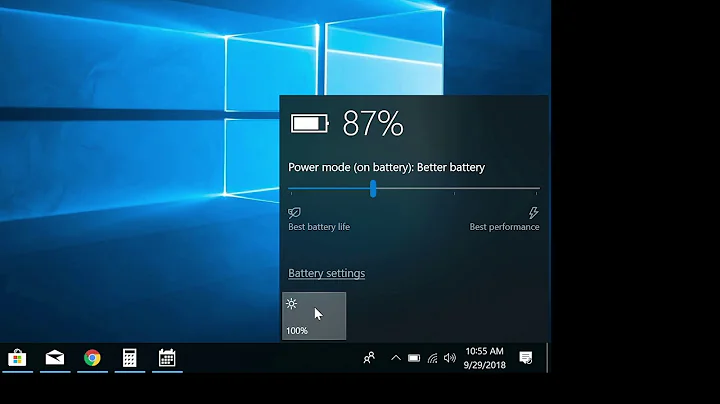How do I make my laptop sleep when it reaches some low battery threshold?
Solution 1
Here's a small script that checks for the battery level and calls a custom command, here pm-hibernate, in case the battery level is below a certain threshold.
#!/bin/sh
###########################################################################
#
# Usage: system-low-battery
#
# Checks if the battery level is low. If “low_threshold” is exceeded
# a system notification is displayed, if “critical_threshold” is exceeded
# a popup window is displayed as well. If “OK” is pressed, the system
# shuts down after “timeout” seconds. If “Cancel” is pressed the script
# does nothing.
#
# This script is supposed to be called from a cron job.
#
###########################################################################
# This is required because the script is invoked by cron. Dbus information
# is stored in a file by the following script when a user logs in. Connect
# it to your autostart mechanism of choice.
#
# #!/bin/sh
# touch $HOME/.dbus/Xdbus
# chmod 600 $HOME/.dbus/Xdbus
# env | grep DBUS_SESSION_BUS_ADDRESS > $HOME/.dbus/Xdbus
# echo 'export DBUS_SESSION_BUS_ADDRESS' >> $HOME/.dbus/Xdbus
# exit 0
#
if [ -r ~/.dbus/Xdbus ]; then
source ~/.dbus/Xdbus
fi
low_threshold=10
critical_threshold=4
timeout=59
shutdown_cmd='/usr/sbin/pm-hibernate'
level=$(cat /sys/devices/platform/smapi/BAT0/remaining_percent)
state=$(cat /sys/devices/platform/smapi/BAT0/state)
if [ x"$state" != x'discharging' ]; then
exit 0
fi
do_shutdown() {
sleep $timeout && kill $zenity_pid 2>/dev/null
if [ x"$state" != x'discharging' ]; then
exit 0
else
$shutdown_cmd
fi
}
if [ "$level" -gt $critical_threshold ] && [ "$level" -lt $low_threshold ]; then
notify-send "Battery level is low: $level%"
fi
if [ "$level" -lt $critical_threshold ]; then
notify-send -u critical -t 20000 "Battery level is low: $level%" \
'The system is going to shut down in 1 minute.'
DISPLAY=:0 zenity --question --ok-label 'OK' --cancel-label 'Cancel' \
--text "Battery level is low: $level%.\n\n The system is going to shut down in 1 minute." &
zenity_pid=$!
do_shutdown &
shutdown_pid=$!
trap 'kill $shutdown_pid' 1
if ! wait $zenity_pid; then
kill $shutdown_pid 2>/dev/null
fi
fi
exit 0
It's a very simple script, but I think you get the idea and can easily adapt it to your needs. The path to the battery level might be different on your system. A little more portable would probably be to use something like acpi | cut -f2 -d, to obtain the battery level. This script can be scheduled by cron to run every minute. Edit your crontab with crontab -e and add the script:
*/1 * * * * /home/me/usr/bin/low-battery-shutdown
Another solution would be to install a desktop environment like Gnome or Xfce (and change your window manager to i3). Both mentioned destop environments feature power management daemons which take care of powering off the computer. But I assume you deliberately don't use them and are seeking for a more minimalistic solution.
Solution 2
As of Debian ≥ 10 (and comparably recent Linux systems), you can just create a file /etc/cron.d/check-battery that contains:
* * * * * root [ "$(cat /sys/class/power_supply/BAT0/status)" != Discharging -o "$(cat /sys/class/power_supply/BAT0/capacity)" -gt 30 ] || systemctl suspend
This will suspend your system whenever the battery level reaches 30%.
Of course, feel free to replace the final suspend with hybrid-sleep, hibernate, poweroff or whatever fits your needs.
No external tools are required, not even the acpi package. This is based on the idea of Matija Nalis' answer, but adjusted to the year 2022.
Solution 3
Instead of hacking your own scripts and if you are using Ubuntu as the tag suggests, you could just install the upower package. It should be available on all Debian derivatives including Ubuntu. By default it comes with a configuration in /etc/UPower/UPower.conf which activates hybrid sleep once the battery level reaches critical values. The default for the critical level is 2%.
For users of other distributions, the relevant entries for /etc/UPower/UPower.conf are:
PercentageAction=2
CriticalPowerAction=HybridSleep
You can also use TimeAction together with UsePercentageForPolicy=false to let the action be carried out once only the specified time is left:
TimeAction=120
The valid values for CriticalPowerAction are PowerOff, Hibernate and HybridSleep. If HybridSleep is set but not available, Hibernate will be used. If Hibernate is set but not available, PowerOff will be used.
The advantage of HybridSleep is, that in addition to writing out memory into your swap area, it then suspends the system. Suspend will still consume some battery but if you come back before the battery ran out, you can much more quickly resume from a suspended system than from a hibernated one. In case the battery does run out before you get back to a power socket, you can resume the system from hibernation once you have power again.
Solution 4
The currently accepted answer is great, but a little bit outdated for Ubuntu 16.04:
- The commands to get battery status have changed.
- The environment variables required for notify-send to work have changed.
- The script given there no longer works from user cron as hibernate requires root.
-
systemctl hibernateis preferred overpm-hibernate.
So, here is the script I use:
#!/usr/bin/env bash
# Notifies the user if the battery is low.
# Executes some command (like hibernate) on critical battery.
# This script is supposed to be called from a cron job.
# If you change this script's name/path, don't forget to update it in crontab !!
level=$(cat /sys/class/power_supply/BAT1/capacity)
status=$(cat /sys/class/power_supply/BAT1/status)
# Exit if not discharging
if [ "${status}" != "Discharging" ]; then
exit 0
fi
# Source the environment variables required for notify-send to work.
env_vars_path="$HOME/.env_vars"
source "${env_vars_path}"
low_notif_percentage=20
critical_notif_percentage=15
critical_action_percentage=10
if [ "${level}" -le ${critical_action_percentage} ]; then
# sudo is required when running from cron
sudo systemctl hibernate
exit 0
fi
if [ "${level}" -le ${critical_notif_percentage} ]; then
notify-send -i '/usr/share/icons/gnome/256x256/status/battery-caution.png' "Battery critical: ${level}%"
exit 0
fi
if [ "${level}" -le ${low_notif_percentage} ]; then
notify-send -i '/usr/share/icons/gnome/256x256/status/battery-low.png' "Battery low: $level%"
exit 0
fi
The environment variables required for notify-send to work are created using this script:
#!/usr/bin/env bash
# Create a new file containing the values of the environment variables
# required for cron scripts to work.
# This script is supposed to be scheduled to run at startup.
env_vars_path="$HOME/.env_vars"
rm -f "${env_vars_path}"
touch "${env_vars_path}"
chmod 600 "${env_vars_path}"
# Array of the environment variables.
env_vars=("DBUS_SESSION_BUS_ADDRESS" "XAUTHORITY" "DISPLAY")
for env_var in "${env_vars[@]}"
do
echo "$env_var"
env | grep "${env_var}" >> "${env_vars_path}";
echo "export ${env_var}" >> "${env_vars_path}";
done
This file needs to run at startup (can be done using any method of your choice; I use Ubuntu's builtin Startup Applications).
Note: sudo systemctl hibernate might not work from cron. Follow this to solve it.
Related videos on Youtube
o_o_o--
Updated on September 18, 2022Comments
-
o_o_o-- over 1 year
I'm using Ubuntu, but I have i3 as my window manager instead of a desktop environment.
When my battery reaches 0%, the computer will just abruptly shut down, no warning or anything.
Is there a simple script or configuration I can set up so that it goes to sleep at, say 4% battery?
-
o_o_o-- almost 11 yearsHm, I tried running
sleepd -b 40and nothing happened after the 40% mark. I also triedsudo sleepd -b 40 -s pm-suspendand nothing happens... -
o_o_o-- almost 11 years(TIL "
cut".) The script works! I haveacpi | cut -f2 -d, | cut -f1 d%-- I'll read about cron to get it to run on its own. Thanks! -
 Tam Borine over 10 yearsI don't have
Tam Borine over 10 yearsI don't have/sys/devices/platform/smapi/directory. Where can I find the remaining percentage of battery power? I am using custom kernel 3.10 -
Marco over 10 years@MartinVegter It depends on your hardware, you can try
/sys/class/power_supply/BAT0/capacity. Otherwise use theacpicommand. -
 Admin about 7 yearsNote: I think
Admin about 7 yearsNote: I thinkHybridSleeprequires to have a swap space. -
 Admin about 7 yearsthat seems very nice! but could that be used with systemd timer instead of cron? (example here) I'm on Solus OS where cron is absent.
Admin about 7 yearsthat seems very nice! but could that be used with systemd timer instead of cron? (example here) I'm on Solus OS where cron is absent. -
josch about 7 years@cipricus that is correct but upower will gracefully choose to shut the machine down instead if it cannot hibernate.
-
Matija Nalis about 7 years@cipricus I guess so, but I avoid systemd so can't give example. I do seem to recall systemd has its own ACPI power handlers, so if you're stuck with systemd you would probably want to avoid clashing with that
-
 Admin about 7 yearsthanks, I have found an alternative involving
Admin about 7 yearsthanks, I have found an alternative involvinguname: github.com/jerrinfrncs/batterynotif/blob/master/… -
 lucidbrot over 3 yearsIs the upower answer obsolete?
lucidbrot over 3 yearsIs the upower answer obsolete? -
Eoin over 3 yearsI don't know if the upower answer is obsolete or not. It just didn't work for me, and I didn't find enough time to investigate and to debug that stuff. And to put it bluntly: Why should I? This simple one-liner is doing its job well. It is reliable since the day I created it, with a minimum of dependencies and system requirements. The only thing I changed since then is increasing the threshold from 10% to 30%.
-
mathur about 3 yearsWhat do the stars mean? Why did you write them?
-
Eoin about 3 yearsEvery file in /etc/cron.d/ is a crontab. The 5 stars mean that the following command is to be executed every minute, and "root" is the user under whose permissions the command is to be executed. See
man 5 crontabfor more details. -
ipcjs almost 3 yearsnote:
.../BAT0/statusmaybe returnUnknown,so it is better to use[ "$(cat /sys/class/power_supply/BAT0/status)" = Discharging -a "$(cat /sys/class/power_supply/BAT0/capacity)" -lt 10 ] && systemctl suspendinstead. -
Eoin almost 3 years@ipcjs Thanks for the hint. I improved my answer accordingly. Note that I'm preferring "!= Discharging" over inverting the whole logic, as the latter would make the command return with a non-zero exit code when everything is fine, which would be quite confusing.
-
Martin Massera over 2 yearsis resume automatic when the battery gets charged or does one have to manually press the power button?
-
josch over 2 years@MartinMassera one has to manually press the power button
-
Alexei Martianov over 2 years@lucidbrot, Just now to Linux Mint 20.2 at least on the fly (w/out reboot) editing UPower.conf has not resulted in action(s) when thresholds were achieved and % decreased even further. Maybe it needs daemon restart, but help (as man page itself notices "not fully documented").
-
Alexei Martianov over 2 yearsShould it (editing UPower.conf) work w/out reboot? I've tried on Linux Mint and it does not. Maybe daemon restart is needed?

![How To Fix Sleep Issues In Windows 10 [Quick Tutorial]](https://i.ytimg.com/vi/YF6_o_qNGeg/hqdefault.jpg?sqp=-oaymwEcCOADEI4CSFXyq4qpAw4IARUAAIhCGAFwAcABBg==&rs=AOn4CLCDvQXXIO27sxHgILX4D76pWxRL6A)


